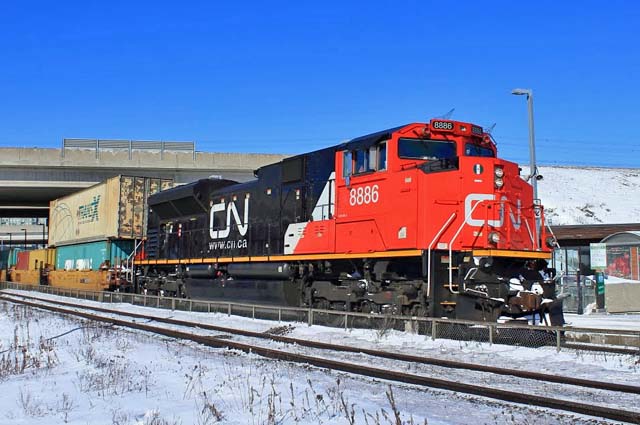
a Bright Spot for CN and CP
Canada - Clarke Trolley likes what he sees from a window overlooking Canadian National Railway's intermodal container yard in Brampton,
Ontario.
The cranes are picking away at the mile-long trains that stretch across the rail yard west of Toronto, lowering the metal boxes onto a stream of
trucks.
The staff lunchroom two floors below is nearly empty as crews prepare for the afternoon train to Montreal.
"What I see now is perfect. People are out doing what they need to be doing, and the cranes are at work," said Mr. Trolley, CN's general manager of
intermodal operations who began his railroading career 23 years ago driving spikes into rail ties.
He now oversees an operation that for CN, and other North American railways, has been a bright spot amid declines in shipments of bulk
commodities.
Intermodal carloads hauled by CN and Canadian Pacific Railway have risen 6 percent in 2015, excluding December, while grain carloads have declined 12 percent,
coal 8 percent, and ores and metals 16 percent, according to Royal Bank of Canada analysts.
During the same period, the two companies have seen overall volumes fall 2 percent amid a plunge in demand for commodities and uncertainty about the North
American economy.
The intermodal business is driven primarily by consumer demand for retail goods, a sector of the economy that has fared better than most.
The metal containers, which are carried by ship, train, and truck, are credited with revolutionizing the global shipping business by making it affordable,
simple, and reliable.
Until the 1960s, ships would idle at port while longshoremen manually unloaded cargo into trucks or boxcars.
The same cargo would have to be unloaded and sorted again at the warehouse.
Christian Wetherbee, a Citigroup analyst, said highway congestion around most North American cities has helped drive manufacturers and retailers to use trains
for the long-haul part of their deliveries.
"Intermodal is absolutely an area for growth for the railroads in Canada as well as the United States.
It's really a North American story and I think it has more room to play out in both geographies," Mr. Wetherbee said.
"It's very difficult to add incremental highway capacity but the rails do have an easier time adding incremental intermodal capacity."
For railways, offering container services requires them to both compete and partner with their rival, the trucking industry.
The rail companies subcontract work to trucking lines, or vice versa.
Simply put, intermodal uses a ship and train for the longest parts of the journey, while a truck hauls the box to its final, local destination.
U.S. consultancy FTR Transportation Solutions predicts 2016 intermodal container traffic in the United States, which includes U.S. operations of CN and CP,
will rise 2.2 percent in 2016, outpacing an overall freight volume increase of 1.6 percent, but lagging growth in the broader economy of 2.5
percent.
CN has all but outgrown its Brampton yard.
The employee parking lot is full, and the 160 trucks that enter each hour must be strictly scheduled to avoid traffic jams around the eight or nine trains that
pull in daily.
That's why CN is planning a new $250 million intermodal terminal in Milton, Ontario, a 400 acre site half an hour away that will handle four trains a
day.
CN is also planning to expand yards in Detroit, Memphis, and Joliet, Illinois, amid expectations new agreements with ports in New Orleans and Mobile, Alabama,
will let it tap the rise in container traffic flowing through the expanded Panama Canal in 2016.
The intermodal container operation is CN's largest business segment, growing by 5 percent to $2.2 billion in the first nine months of 2015 to account for 20
percent of total freight sales.
(Petroleum and chemicals are a close second, followed by grain and fertilizers.)
At CP, where total revenue is half that of CN, intermodal shipping accounts for 21 percent of sales.
The segment has been flat in the first three quarters of 2015, a period in which overall revenue growth of 3 percent has been held back by a 19 percent plunge
in crude oil revenue.
But between 2013 and 2014, CP's domestic intermodal revenue shot up 15 percent on new demand for its Toronto-Montreal service.
Jean-Jacques Ruest, CN's executive vice-president and chief marketing officer, said intermodal service pairs the efficiency and low cost of rail shipping with
the flexibility of truck transport.
"In order for us to compete with the trucking industry and compete with all the infrastructure provided to it, all the highways and whatnot, and the fact
most customers that did construction the past 20 years did not put in a rail siding, we need to offer a product that starts with the road and finishes with the
road," Mr. Ruest said in an interview.
"The container business can do that."
Eric Atkins.


